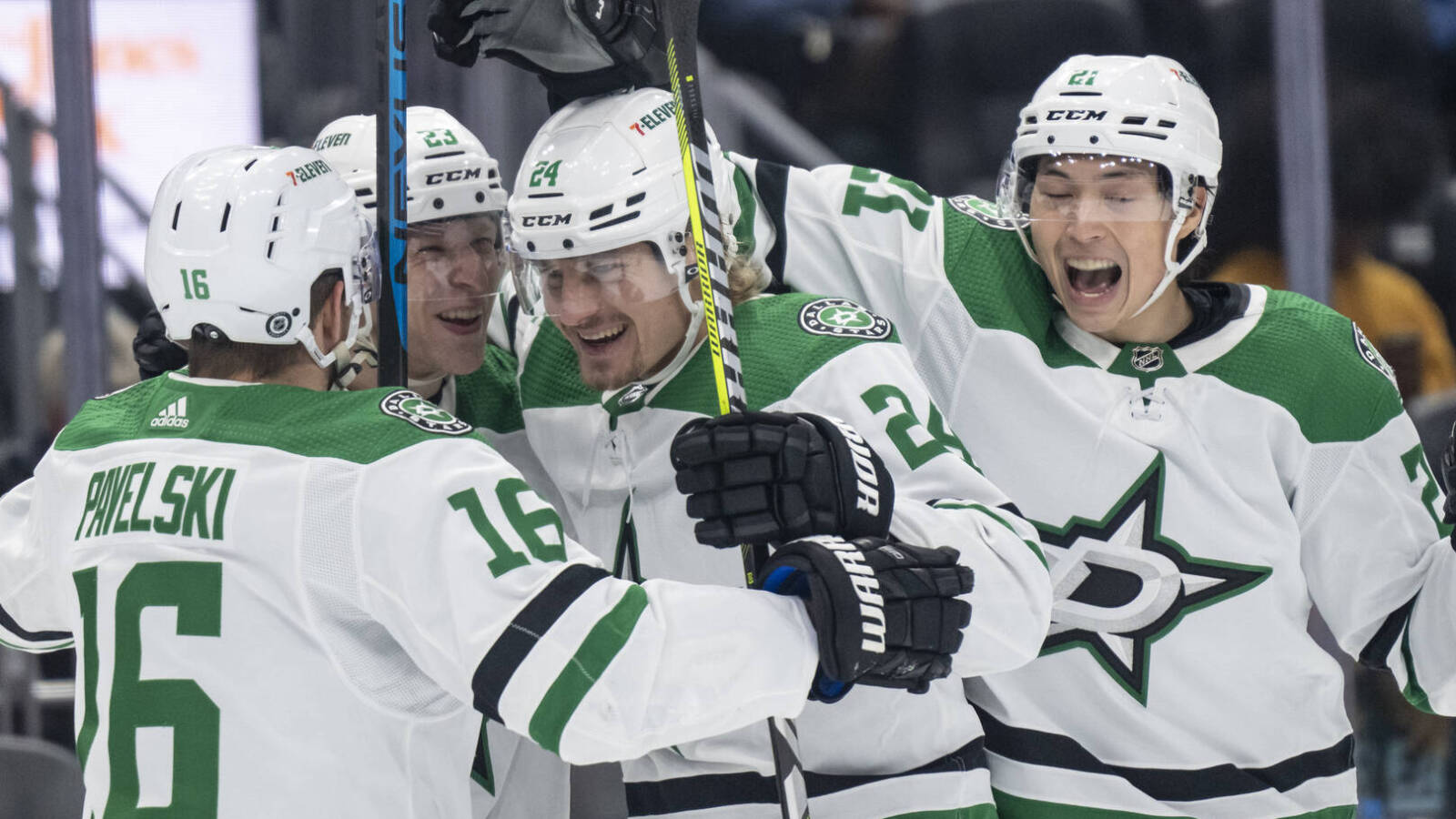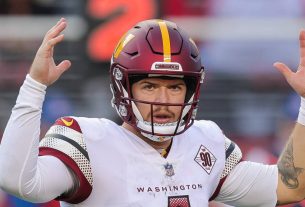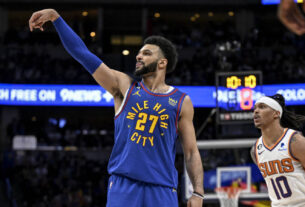There’s something fun about seeing a line of three players who just complement each other so well. Sometimes it’s because three elite and unique skillsets blend together to perfection, and sometimes it’s because three players have played together for years and just know where the others are going to be, but when it works, it’s a sight for the eyes to see.
With that, let’s look into which lines have done that this year. Some take a more traditional approach of sniper, playmaker and power forward, some are a combination of defensive stalwarts making up the perfect shutdown line and some are just all-in on offense, but all of them know how to bring the results in the end.
There were a few qualifications put in place for this list, mostly with ice time. Each line has to have played more than 250 minutes at 5-on-5 together, and each player must be in the top two of their other two line mate’s most common forward partners this season, with the lone exception being Mark Stone with Vegas as his injuries put him third on Jack Eichel’s line mates list.
Nick Schmaltz – Barret Hayton – Clayton Keller (Arizona Coyotes)
There’s a reason the Coyotes have been playing above .500 hockey since the All-Star Break, and that’s due to their top line. It’s a composition of players that at one point seemed like players the Coyotes spent high draft and trade capitol on for limited returns, but they have been living up to their draft slots or trade returns this year.
For more than a year, Schmaltz and Keller have been producing at above a point-per-game pace but haven’t quite gotten the attention due to, well, playing in Arizona. Keller has always been an excellent playmaker but is taking advantage of his shot more, scoring at a 40-goal pace, while Schmaltz has established great chemistry with Keller over the years to become the perfect complementary piece. And then Hayton provides that cliché element of forechecking to add the final touch to this line that allows it to dominate. The fact that they’ve been putting up great numbers on an otherwise abysmal Coyotes team speaks volumes to how great this line is.
Brad Marchand – Patrice Bergeron – Jake DeBrusk (Boston Bruins)
Marchand and Bergeron are no strangers to lists like these, likely sitting at the top for years alongside David Pastrnak when the Perfection Line was the staple of the Bruins’ lineup. However, depth issues last season caused then-Bruins coach Bruce Cassidy to move around the lineup, dropping Pastrnak down to drive the second line while putting DeBrusk on with Marchand and Bergeron, and not surprisingly, those two didn’t miss a beat with their new partner.
There’s not a lot to say about Bergeron and Marchand that hasn’t already been said for the past several seasons, but these two have been possession monsters for years, and that’s what made that initial Perfection Line so terrifying. The fact that they could split it up to basically make that a two-line threat is what makes the Bruins even tougher to beat this year. DeBrusk has had a career year alongside them and provided an all-around impact of his own to act as that ideal third option, which in turn has allowed Pastrnak to thrive in a slightly easier role and have the dominant season he’s had.
Andrew Mangiapane – Mikael Backlund – Blake Coleman (Calgary Flames)
While Backlund has been a play-driving machine for quite some time in Calgary, anchoring that second line no matter who he’s played with or how bad the team around him has been. It should be no surprise that a line with him makes this list.
And it’s even less of a shock that adding Coleman to this line makes it even better. Coleman was a big part of two Stanley Cup wins in Tampa Bay as a part of their famous third line shutdown unit with Yanni Gourde and Barclay Goodrow, so adding him to Backlund’s wing has made them almost unstoppable from a possession standpoint. Mangiapane acts as the finisher for the trio, and while he’s seen some regression this season from his 35-goal campaign in 2021-22, when he’s on it makes this line all that much harder to handle.
Jordan Martinook – Jordan Staal – Jesper Fast (Carolina Hurricanes)
No line has spent more time together than Martinook, Staal and Fast, which is impressive when you remember that this is the Hurricanes’ third line. It just goes to show how reliable it is as the go-to shutdown line for the Canes. Even though their point totals aren’t anything to write home about, they make a dominant play-driving line, and no one better personifies Carolina’s aggressive forechecking identity than this trio.
Of any line combination that’s spent more than 250 minutes together, this one has allowed the second-fewest expected goals against in the league, and it’s by committee as opposed to one specific member driving the bus. Sure, Staal is the defensive specialist and does it the best of the three, but Martinook and Fast are no slouches either, allowing them to gel perfectly and keep the Canes out of their own end for the most part. They don’t produce as well as some of the other lines on this list, but they’re more or less a black hole when they’re on the ice, a perfect thing to have when leading an important game late and you want nothing to happen.
Jason Robertson – Roope Hintz – Joe Pavelski (Dallas Stars)
A sniper, a playmaker and a power forward, a combination as old as time. It’s the stereotypical line combination for a reason, as the playmaker moves the puck up the ice and sets up the chances, the sniper buries the initial set-up and the power forward is there to create chaos in front of the net and occasionally tip home or get the rebound on the shots the sniper doesn’t finish. It’s a trio of player types that work fluently together, and no line better encapsulates that than Robertson, Hintz and Pavelski.
Robertson is the big name on the line, as he’s already emerged as one of the game’s elite forwards. Back-to-back 40-goal seasons have shown that he can bury the puck like the best of them. Hintz is the underrated complementary piece for Robertson, making up for the winger’s slower footspeed with excellent skating and the ability to knife through the neutral zone and set him up. And then you have Pavelski doing what Pavelski does, parking himself in front of the net and tipping home any of the shots not already going in, while also providing some elite defense. They’ve worked to perfection for several seasons now, and it’s a big reason why the Stars are such a threat in the West.
Zach Hyman – Connor McDavid – Leon Draisaitl (Edmonton Oilers)
Are you all that surprised to see this trio on here? They don’t play together that often, but they dominate when they do. I probably would have docked them in the past for their lack of defensive play, but McDavid has seen a significant step up in that regard to turn them into a play-driving unit that is right with the other lines, if not better than most. At the very least, he’s masked up Draisaitl and Hyman’s deficiencies in their own zone to the point that them being the most productive line in the NHL is more than enough to make it.
I doubt I have to talk too much about why a combination of McDavid and Draisaitl work together, as the two have sat in the top five in scoring for the past five seasons. Sometimes they play separately to spread out the attack, but when both are on the ice, the only way you’re stopping them is if you hold them in their own zone the whole time, and even then McDavid could still burn you with his speed if you turn it over. It shouldn’t be a surprise that Hyman acts as the perfect complementary piece here as an aggressive forechecker and net-front presence, as he did this for years in Toronto next to more of the game’s best in Auston Matthews and Mitch Marner. It’s allowed him to be even more productive in Edmonton, giving him his best season at 30 years old.
Carter Verhaeghe – Sam Bennett – Matthew Tkachuk (Florida Panthers)
Even with the Panthers fighting for their playoff lives, Tkachuk has been worth every asset that they spent in their trade and every penny that they spent on his new contract. He’s called a unicorn for a reason, providing a high-end level of peskiness and net-front presence to the Panthers while also being an elite play-driver and defender. He’s got it all, and there’s a reason the Panthers sought him even though the cost set them back a bit.
He’s perfectly complemented two of Florida’s reclamation projects in Verhaeghe and Bennett. Bennett just didn’t put it together in Calgary, but has been an offensive force in Florida, while Verhaeghe went through a long stretch of development in Tampa Bay to become an NHL player before the Panthers turned him into an elite threat. Neither of them defends that well, which is what Tkachuk helps them out with in particular, and the trio have been a big driver of Florida’s offense that has actually taken a step forward from last year in shot and scoring chance generation, even if it hasn’t shown up on the scoreboard all the time.
Brady Tkachuk – Tim Stutzle – Claude Giroux (Ottawa Senators)
Out of all the big-name free agent signings in 2022, Giroux has certainly been an underrated addition that’s paid off big time for the Senators. While he’s not the 100-point player that he was in his prime, what he has provided for the Senators is being the perfect complementary piece to insulate their two franchise cornerstones up front in Stutzle and Tkachuk.
Stutzle showed signs of superstardom in 2021-22, but his inability to drive play was holding him back. Giroux has done just that for this line, allowing Stutzle to thrive and become an elite scorer in the NHL. That in turn has created more opportunities for Tkachuk. Tkachuk’s finishing ability is still bad (he only has 34 goals on 47.16 expected goals), but with more opportunities, he’s still dangerous. Tkachuk and Stutzle need some improvement on the defensive end, but that’s what Giroux has helped shelter a bit, allowing this line to thrive to the point of being one of the best in the league.
Jake Guentzel – Sidney Crosby – Rickard Rakell (Pittsburgh Penguins)
The Penguins’ top line has not only been their most common combination this season, but these three players have spent the fifth most time together of any trio in the NHL this season. They don’t put up as crazy numbers as some of the other lines featured here, but there’s something to be said about consistently driving play and scoring goals with so much ice time, meaning there’s also a lot of opportunity for it to go the other way.
There’s no denying that Crosby is the main driver of this line, but he and Guentzel have always had a connection and have placed in the top 10 of forward duos for ice time in the past three years, including the most in both 2020-21 and this season. Guentzel has given Crosby a line mate that comes with his own skillset, particularly his finishing ability, and Rakell has given both of them another option since joining the Penguins at the deadline last season. Neither winger is exactly great at defense, but they don’t need to be playing with Crosby, allowing them to focus on the offensive side of the game.
Chandler Stephenson – Jack Eichel – Mark Stone (Vegas Golden Knights)
As Vegas deals with its injury problems, it’s resulted in this line not getting as much time together as would be expected. But when they have been together, it’s been a nightmare for the opposition. The duo of Eichel and Stone is what really makes it work, especially as Eichel has finally gotten healthier and returned to his elite form.
With Eichel back in action, it gives the Golden Knights the elite center that they’ve needed, and it gives them a scoring threat that other teams have to worry about. With Stone on his wing, it’s all the more of a concern, as his elite defensive play means this line will likely be in the offensive zone for the whole shift to give Eichel those chances, and Stone is no slouch in the offensive department either. Stephenson is definitely more of a passenger than a driver here, but he has turned into a solid point producer for the past couple seasons, and makes for a good third piece on this line.



